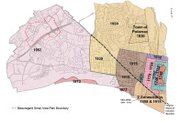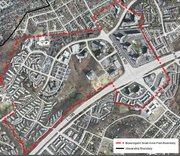Alexandria planning officials are recommending a plan that would upzone 6 million square feet of existing buildings to 12.4 million square feet, asking for $148 million in exchange from developers to fund a fire station, pay for transit infrastructure and create dedicated affordable housing units. Alexandria Department of Planning and Zoning
Ever since city officials annexed the half of Alexandria west of Quaker Lane in 1952, the West End has had to fight for a place at the table. Alexandria is a city where Del Ray and Old Town seem to hog the spotlight, and people who live on the suburban streets named for Confederate heroes have long said they feel ignored. West End residents feel particularly slighted by the recent Department of Defense installation at the Mark Center, which has already clogged the intersection of Seminary Road and Beauregard Street enough to earn it a failing grade from city transportation officials.
“I feel like the West End is always getting the crumbs of the cookie,” said Jim Brown, who has lived in the West End for 62 years. “It’s about time we got some of the cookie.”
City officials are about to focus a major spotlight on the West End of Alexandria, although some are saying that the light is a garish display of wealth and power. Five developers have been working with city officials for months to craft the Beauregard small-area plan, which will add millions of square feet of development to the community and drastically increase the value of the land. In exchange for the windfall profits, the developers have agreed to fork over $147.5 million in contributions. Some say it’s a Faustian bargain.
“When they talk about fields and open space, that sounds wonderful,” said Esteban Garces, an organizer with Tenants and Workers United. “But it’s important to remember that will come at the expense of displacing people who live here now.”
THE FUTURE OF THOUSANDS of low-income residents is at stake, pitting wealthy developers against the city’s poorest residents. Caught in the balance are the city’s elected leaders, who are trying to navigate through the planning process. The current proposals call for adding 700 units affordable housing units, although qualifying for them will require that recipients earn between 55 percent to 80 percent of the area median income. At the low end, that means that a family of four must earn at least $59,000 a year to qualify for one of the dedicated affordable housing units. Meanwhile, thousands of low-end housing units will be torn down to make way for redevelopment. During a recent work session between members of the City Council and Planning Commission, some participants were skeptical.
“Once those are gone, they’re gone for good,” said Planning Commission member Eric Wagner. “We are not getting them back.”
Wagner and others have been critical of the temporary nature of the dedicated affordable units that are part of the deal with developers. Like Cinderella’s time at the ball, these units are set to expire after a certain number of years. That means that city leaders of a future generation would have to figure out how to handle the affordable housing problems then without the benefit of permanently dedicated units. Some have called for the city to boost the number of dedicated units beyond 700, although housing officials say that would upset the balance that has already been negotiated.
“Follow the money,” said Planning Commission member Stu Dunn. “There are people who are going to make a lot of money on this, and I’m concerned that the people on the other side haven’t been heard.”
THE COMING DECADES are certain to see drastic change on the West End. A recent study by the Metropolitan Washington Council of Governments concluded that in the next 30 years, Alexandria is projected to add 52,000 new jobs, 43,000 new residents and 24,000 new housing units. The new Washington Headquarters Service at the Mark Center, which added more than 6,000 daily commuters to the West End, may be the tip of the iceberg.
“We knew we couldn’t rely on one mode of transportation to manage that traffic,” said Abi Learnier, deputy director of Transportation and Environmental Services. “We knew we had to create a multi-modal approach.”
The solution is a high-capacity transit corridor that snakes through the West End, connecting Shirlington and the Pentagon. The transitway will include elements such as larger stations with real-time information, new signs, improved transit headways and rapid transit vehicle with a greater capacity than a typical local bus. The centerpiece of the transportation network is a controversial ellipse at Seminary Road and Beuregard Street designed to eliminate left turns from both directions on Seminary, redirecting those movements in a way similar to a traffic circle.
“I am not convinced by anything I have seen or read this will work,” said Councilwoman Del Pepper, who lives on the West End. “It may work on paper, but I don’t’ think it will work in reality.”



